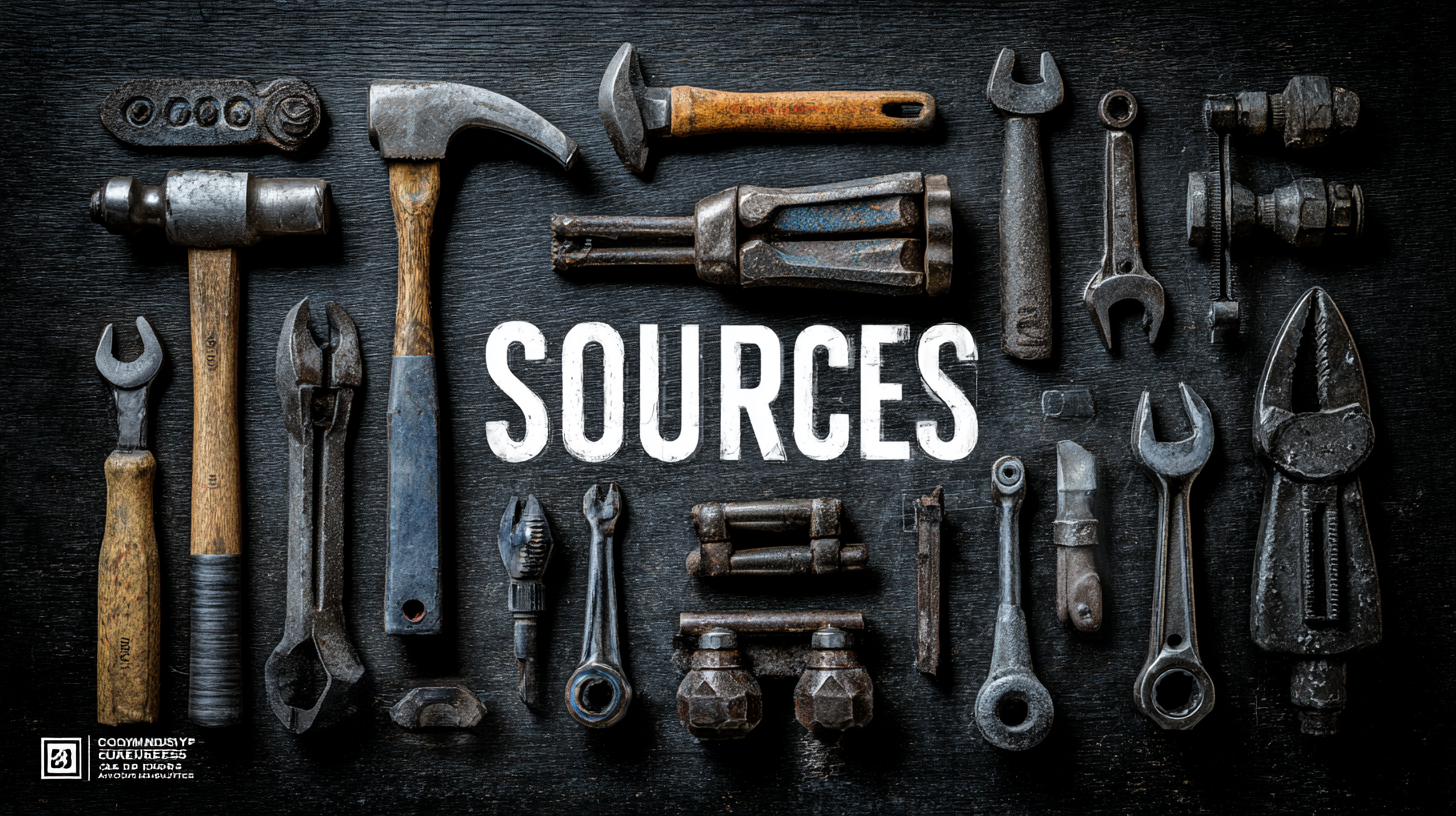
How to Source Quality Suppliers for the Best Tools Set and Achieve Competitive Advantage
In today's competitive marketplace, sourcing quality suppliers for the best tools set is essential for businesses aiming to establish a sustainable competitive advantage. According to a recent industry report by MarketResearch.com, the global tools set market was valued at approximately $18 billion in 2022 and is projected to grow at a CAGR of 5.2% through 2027. This growth underscores the increasing demand for high-quality tools that meet specific technical parameters, such as durability, ergonomics, and precision. Companies that leverage effective supplier sourcing strategies will not only enhance their product offerings but also improve their operational efficiency and customer satisfaction. By focusing on identifying reliable suppliers with proven track records, businesses can secure the best tools set that aligns with their quality standards and market demands.

Identifying Key Metrics for Evaluating Supplier Quality in Tool Manufacturing
When sourcing quality suppliers for tool manufacturing, it's essential to establish key metrics that effectively evaluate their performance and reliability. One crucial metric is the supplier’s production consistency, which measures their ability to deliver products that meet predefined specifications over time. Evaluating historical data on defect rates and adherence to timelines can provide insights into their operational stability. Consistent production indicates not only quality but also a supplier's dedication to maintaining high standards, which directly impacts your own product's quality and reputation.
Another important metric is the supplier's capacity for innovation. In the fast-paced tool industry, suppliers who invest in research and development can offer cutting-edge solutions that provide a competitive edge. Evaluating their track record in developing new technologies and improving existing products can help identify suppliers who will not only meet your current needs but also anticipate future ones. Additionally, measuring supplier responsiveness—how quickly they handle inquiries, address issues, and adapt to changes—can further indicate their willingness to collaborate and support your business in a dynamic market.
Emerging Technologies Influencing Supplier Selection in 2025
As we approach 2025, emerging technologies are set to reshape the landscape of supplier selection, enabling businesses to source quality suppliers for tool sets more efficiently. Artificial intelligence (AI) and machine learning are becoming indispensable in analyzing supplier performance data and market trends. According to a recent McKinsey report, companies that adopt advanced analytics in their supplier selection processes can reduce procurement costs by up to 15% and improve supplier lead times by nearly 30%. These technologies allow for real-time data processing, granting businesses a competitive edge in identifying and partnering with the best suppliers.

Blockchain technology is also emerging as a crucial tool in supplier verification and supply chain transparency. A study by Deloitte highlights that 55% of companies plan to implement blockchain solutions by 2025 to enhance traceability and ensure quality assurance in procurement processes. By leveraging blockchain, organizations can track product journeys, authenticate supplier credentials, and reduce the risk of counterfeit tools. This shift toward transparency not only fosters trust between suppliers and buyers but also aids companies in making informed decisions, thus positioning them to achieve a significant competitive advantage in the market.
Leveraging Data Analytics to Optimize Supplier Performance for Competitive Edge
In today’s fast-paced market, leveraging data analytics to optimize supplier performance is crucial for obtaining a competitive edge. A recent report by McKinsey highlights that companies utilizing advanced analytics can boost their supplier management efficiency by up to 15%. By systematically analyzing supplier data, businesses can identify key performance indicators (KPIs) that reflect the reliability and quality of their suppliers, ensuring they secure the best tool sets to meet their operational needs.
Furthermore, the ability to predict supplier risks through data-driven insights allows companies to mitigate disruptions more effectively. Research from Deloitte indicates that organizations focused on data analytics experience a 10-20% cost reduction in supply chain management. By integrating analytics into supplier selection and evaluation processes, businesses not only streamline their procurement strategies but also enhance their resilience against market fluctuations. This strategic approach not only helps in selecting superior suppliers but also fosters long-term partnerships that can adapt to evolving industry demands.
How to Source Quality Suppliers for the Best Tools Set and Achieve Competitive Advantage - Leveraging Data Analytics to Optimize Supplier Performance for Competitive Edge
| Supplier Name | Product Category | Quality Score (1-10) | Delivery Time (Days) | Price Index (USD) | Sustainability Index (1-5) |
|---|---|---|---|---|---|
| Supplier A | Power Tools | 9 | 5 | 150 | 4 |
| Supplier B | Hand Tools | 8 | 3 | 100 | 3 |
| Supplier C | Measuring Tools | 7 | 10 | 75 | 5 |
| Supplier D | Safety Gear | 9 | 4 | 200 | 4 |
| Supplier E | Power Equipment | 8 | 7 | 300 | 3 |
Sourcing Locally vs. Globally: Understanding Market Trends in Tool Supply Chains
When it comes to sourcing quality suppliers for tool sets, one key consideration is whether to focus on local or global suppliers. Sourcing locally often provides the advantage of shorter delivery times and easier communication, which can be crucial for maintaining quality control. Local suppliers may also have a better understanding of regional market demands and can adapt quickly to changes, helping businesses remain agile and responsive to customer needs.
On the other hand, global sourcing has its own set of advantages, particularly in terms of cost efficiency and access to a wider variety of products. Companies can often find high-quality suppliers in countries with lower manufacturing costs, allowing them to offer competitive pricing in their markets. However, navigating global supply chains requires a keen understanding of international trade regulations, potential tariffs, and cultural differences that may affect supplier relationships.
As market trends continue to evolve, businesses must strategically weigh these factors to establish a robust supply chain that supports their growth objectives while capitalizing on both local and global opportunities.
Best Practices for Building Long-Term Partnerships with Quality Tool Suppliers
 Building long-term partnerships with quality tool suppliers is crucial for businesses seeking a competitive edge in the market. First and foremost, establishing clear communication channels is essential. This not only fosters trust but also ensures that both parties are aligned on expectations, delivery timelines, and quality standards. Regular check-ins and open dialogues help to address issues promptly and reinforce commitments. By treating suppliers as strategic partners rather than just vendors, businesses can cultivate a collaborative atmosphere that encourages innovation and improvement.
Building long-term partnerships with quality tool suppliers is crucial for businesses seeking a competitive edge in the market. First and foremost, establishing clear communication channels is essential. This not only fosters trust but also ensures that both parties are aligned on expectations, delivery timelines, and quality standards. Regular check-ins and open dialogues help to address issues promptly and reinforce commitments. By treating suppliers as strategic partners rather than just vendors, businesses can cultivate a collaborative atmosphere that encourages innovation and improvement.
Another best practice is to conduct thorough evaluations before entering into partnerships. This includes assessing suppliers’ production capabilities, quality control processes, and their track record in terms of reliability and customer service. Further, investing time in visits to suppliers’ facilities can provide deeper insights into their operations and culture. By choosing suppliers who share similar values and commitment to quality, businesses can enhance their overall tool offerings while also mitigating risks associated with supply chain disruptions. Emphasizing long-term relationships rather than short-term gains not only benefits individual businesses but also supports the overall health of the industry.
